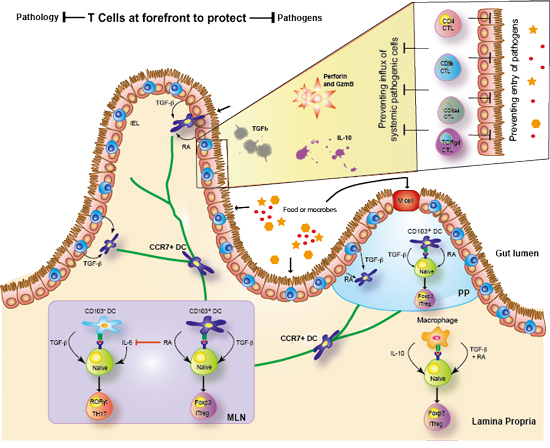Laboratory for Immune Crosstalk
Current research
Our research continues to elucidate mechanisms of mucosal immune protection and regulation and, in a recent study, we uncovered an unexpected degree of plasticity for CD4 T helper (Th) cells, which upon antigenic stimulation, are able to terminate the expression of the Th transcription factor, ThPOK, and differentiate into cytotoxic T lymphocytes (CTL). At steady state, CD4 CTL remain quiescent and express a self-regulated phenotype. However under challenging conditions, these cells have the potential to transform into potent inflammatory killer effector cells (Mucida et al., Nature Immunology 2013).
Overall, based on the insights we are gaining from our research, a clear picture has begun to emerge showing that the immune defense of the intestine adapts to the local environment and specializes to provide the most efficient and immediate protection in the face of preserving the integrity of the most critical mucosal barrier of the body.
In another study, we are aiming to understand the various mechanisms and processes that lead to Central Tolerance. Our previous research showed that in addition to conventional selection, a process of so called “agonist” selection operates in the thymus, which preserves self-specific thymocytes and functionally differentiate these precursor cells to become beneficial pre-programmed protective or regulatory T cells. In an effort to understand what factors control the decisive checkpoint during thymic selection, we identified “Themis” as a critical switch. We are now trying to elucidate the molecular and cellular factors and events that connect the Pre-TCR and TCR signal strength with thymic selection and the fate decision of the developing T cells.

Figure: Intraepithelial lymphocytes (IEL) protect the mucosal barrier of the intestine from pathogen- and inflammation-induced pathology.
T cells that reside within the epithelium of the intestine are phenotypically heterogeneous but they are all specialized to protect the mucosal barrier against pathogen- and immune cell-induced pathology. In contrast to the T cells in the periphery, IEL are antigen-experienced T cells that encountered their antigen initially during selection in the thymus (agonist selected CD8aa TCRab and TCRgd precursor cells) or as mature cells in the periphery (CD8ab CTL and CD4 CTL). Although the various IEL subsets display different antigen specificity and MHC restriction and although they follow different paths of effector differentiation, they all acquire cytolytic and regulatory capacity. The functional specialization of IEL adapts them to provide optimal protection in the face of preserving the integrity of the delicate mucosal barrier.



